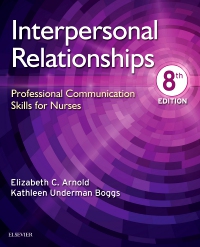
Interpersonal Relationships Elsevier eBook on VitalSource, 8th Edition
Elsevier eBook on VitalSource

Now more than ever, effective communication skills are key for successful patient care and positive outcomes. Interpersonal Relationships: Professional Communication Skills for Nurses, 8th Edition helps students develop skills in communicating effectively with clients, families, and colleagues in order to achieve treatment goals in health care. Using clear, practical guidelines, it shows how to enhance the nurse-client relationship through proven communication strategies as well as principles drawn from nursing, psychology, and related theoretical frameworks. The 8th edition includes engaging new content relating to current issues, while also emphasizing interdisciplinary communication and QSEN competencies. Students will learn how to apply theory to real-life practice through case studies, interactive exercises, and evidence-based practice studies.
Newer Edition Available
Interpersonal Relationships Elsevier eBook on VitalSource
-
- UPDATED! Perspectives and Contemporary Dynamics chapter is revised to be more engaging and link the content closer to current issues and related communication concepts
- UPDATED! Communicating in Groups chapter includes professional and task small group communication applications
- UPDATED! Most chapters have been retitled and expanded to highlight a stronger emphasis on interdisciplinary health team communication
- UPDATED! Safety and Quality in health care delivery (QSEN) competencies reflects current thinking on technology, safety, and evidence-based practice, especially as they relate to communication in nursing
- UPDATED! Content throughout text includes stronger emphasis on collaborative communication with related evidence based case studies and analysis
- UPDATED! Expanded content related to socio-cultural communication competencies reduce health disparities and increase health literacy
- NEW! simulated exercises and discussion questions help students practice their reflective analysis skills
- Revised content on social media and transitional care delivery reflects current practice standards
- Interactive exercises let students practice, observe, and critically evaluate their professional communication skills in a safe learning environment
- Case examples help students learn to develop empathy for clients' perspectives and needs
- NEW! Engaging content on current issues and communication concepts is included in this new edition
- Discussion of spirituality and end-of-life needs focuses on trust, empathy, and the nurse-client relationship — all central components of holistic nursing identified by The Joint Commission as priorities for patient care
- Nursing, behavioral, developmental, family, and communication theories provide an essential foundation and a theoretical perspective for effective communication
- Ethical Dilemma and Evidence-Based Practice boxes help students absorb and retain key ethical content throughout text
- Separate chapters on communication across the lifespan highlights crucial communication tools that are the first step in developing a culture of safety in contemporary health care delivery
-
- NEW! Engaging content links the text to current issues and communication concepts
-
Part I: Theoretical Foundations and Contemporary Dynamics in Patient Centered Relationships and Communication
1. Historical Perspectives and Contemporary Dynamics
2. Clarity and Safety in Communication
3. Professional Guides for Nursing Communication
4. Critical Judgment: Critical Thinking and Ethical Decision Making
Part II: Essential Communication Competencies
5. Developing Patient Centered Communication Skills
6. Variation in Communication Styles
7. Intercultural Communication
8. Communicating in Groups
Part III: Relationship Skills in Health Communication
9. Self-Concept in Professional Interpersonal Relationships
10. Developing Patient Centered Therapeutic Relationships
11. Bridges and Barriers in Therapeutic Relationships
12. Communicating with Families
Part IV: Communication for Health Promotion and Disease Prevention
13. Resolving Conflicts Between Nurse and Patient
14. Communication Strategies for Health Promotion and Disease Prevention
15. Communication in Health Teaching and Coaching
16. Communication in Stressful Situations
Part V: Accommodating Patients with Special Communication Needs
17. Communicating with Patients Experiencing Communication Deficits
18. Communicating with Children
19. Communicating with Older Adults
20. Communicating with Patients in Crisis
21. Communication in Palliative Care
Part VI: Collaborative Professional Communication
22. Role Relationship Communication within Nursing
23. Interprofessional Communication
24. Communicating for Continuity of Care
25. Documentation in Health Information Technology Systems
26. Health and Communication Technology


 as described in our
as described in our 